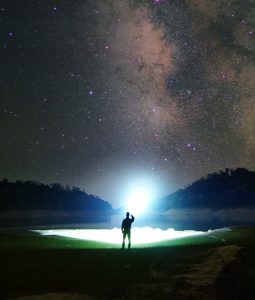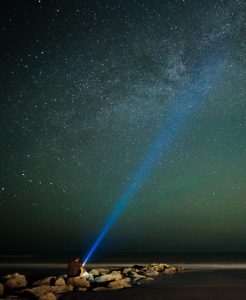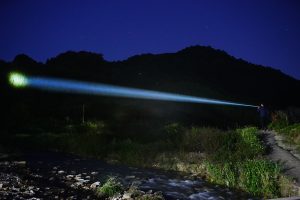Key Takeaways:
- LEP flashlights use a laser to create a bright and long-range beam
- LEP flashlights are also more efficient compared to other flashlights
- LEP and LED flashlights differ in their internal systems, brightness, and more.
How do LEPs work?
LEP flashlights emit a blue laser beam that excites a material called phosphor. This phosphor absorbs the laser energy and subsequently emits visible light. The flashlight then utilizes lenses or reflectors to focus this light, resulting in the distinctive bright white and long-reaching LEP beam.
Unparalleled Brightness
LEP flashlights are renowned for their exceptional brightness. The laser-driven technology produces a highly concentrated beam that can outshine even the brightest LED flashlights. With their luminosity reaching astonishing levels, LEP flashlights provide an illuminating experience like no other. Whether you're camping in the wilderness, exploring caves, or working in low-light conditions, these flashlights will effortlessly light up your surroundings, allowing you to navigate with ease and confidence.
Incredible Long Range Distances
The use of a laser enables LEP flashlights to produce an incredibly tight and long-range beam, such as the Nitecore P35i, which can reach over a mile. LEP flashlights also employ specially designed optics and reflectors to shape and direct the emitted light into a focused beam. The combination of the laser's inherent focus and the flashlight's optics/reflector system enables the light to be projected over long distances without significant spreading or loss of intensity. The design of these optical components plays a crucial role in achieving an extended beam range.
Efficient Power Consumption
LEP flashlights consume less power thanks to their highly efficient laser diode. This diode converts electrical energy into light with minimal energy wastage into heat. As a result, LEP flashlights deliver brighter illumination while conserving power. This efficiency ensures extended battery life, enabling users to rely on their LEP flashlights for longer durations without the hassle of frequent battery changes or recharging.
What’s the difference between LEP and LED flashlights?
Different internal systems
While LEP flashlights use a laser to produce a beam of light, a LED flashlight works by passing an electrical current through a microchip, causing electrons and holes to meet at the chip's junction and generate light. LED flashlights typically feature a driver circuit to regulate the current and rely on power sources such as batteries.

Brightness Levels
Many LEP flashlights typically do not have a low brightness setting due to the nature of their laser-based technology. Unlike LED flashlights that can be easily adjusted to different brightness levels by controlling the electrical current supplied to the LEDs, LEP flashlights rely on the laser excitation of phosphor to produce light. The laser diode used in LEP flashlights operates at a fixed power output, which results in a consistent and high-intensity beam. As a result, LEP flashlights often lack a low brightness setting or have limited dimming options. However, some manufacturers may incorporate additional features or technologies to provide adjustable brightness levels in LEP flashlights, but it is not as common as in LED flashlights.
Beam Characteristics
LED flashlights generally have a wider beam spread compared to LEP flashlights. LEDs emit light over a broader angle, resulting in more widespread illumination. This wider beam spread makes LED flashlights suitable for general area lighting and closer-range illumination where broader coverage is desired.
LEP flashlights typically offer a more consistent beam pattern throughout their range. Due to laser technology and precision optics, the beam profile of an LEP flashlight tends to maintain its focus and intensity over longer distances.

Efficiency
LEP flashlights are designed to be highly power-efficient. The laser diode used in LEP technology is known for its efficient conversion of electrical energy into light, resulting in brighter illumination while consuming less power compared to LEDs. LEDs are generally power-efficient as well and have a reputation for consuming low amounts of energy. However, when they convert a significant portion of electrical energy into light, some energy is lost as heat. This energy that is lost as heat is why most LEP flashlights are more efficient than LED flashlights.
Application
LEP flashlights are relatively newer and are gaining popularity among outdoor enthusiasts, search and rescue teams, and professionals who require powerful and long-range illumination. LEP technology is particularly beneficial where a focused and intense beam is necessary, such as long-distance spotting or specific tasks requiring precision.
LEDs are used in various lighting applications, such as residential and commercial lighting, automotive lighting, and electronic displays like TVs and computer screens. LED flashlights are commonly used for everyday tasks, outdoor activities, and emergency lighting.

See a LEP Flashlight in action!
Recap:
LEP flashlights are revolutionizing portable lighting with their extraordinary brightness, extended range, and efficient power consumption. Their laser-driven technology and highly focused beams make them invaluable tools for various applications. While LED flashlights remain versatile and widely used, LEP flashlights have carved a niche for themselves in situations that demand powerful, long-range illumination.


thank u ,that was interesting I appreciate you taking time to share